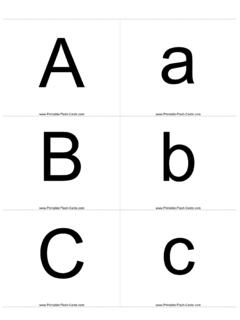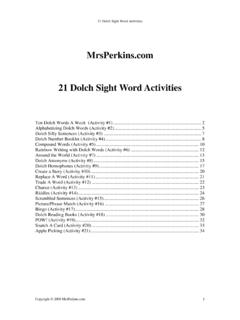Transcription of Plant and Animal Cells - VDOE
1 Science Enhanced Scope and Sequence Life Science Plant and Animal Cells Strand Life Systems Topic Investigating organelles and their functions in Cells of living things Primary SOL The student will investigate and understand that all living things are composed of Cells . Key concepts include: a) cell structure and organelles;. b) similarities and differences between Plant and Animal Cells ;. c) development of cell theory; and d) cell division. Related SOL LS. 1 The student will demonstrate an understanding of scientific reasoning, logic, and the nature of science by planning and conducting investigations in which d) models and simulations are constructed and used to illustrate and explain phenomena. Background Information The Animal cell is a eukaryotic cell. It is surrounded by a cell membrane, which forms a selective barrier that allows nutrients to enter and waste products to exit.
2 The cytoplasm contains a number of specialized organelles, each of which is surrounded by a membrane. The nucleus contains all the genetic information necessary for cell growth and reproduction. The other organelles carry out the different functions of the cell, allowing it to survive and participate in the functioning of the larger organism. The other organelles (vacuole, mitochondrion, endoplasmic reticulum) are found throughout the cell in more than one copy. The Plant cell is a eukaryotic cell but is unique among the eukaryotes because it contains chloroplasts, which are able to produce food for the organism. The Plant cell contains the other organelles present in the Animal cell, as well as a cell wall, which provides structure and support for the cell. The vacuole in the Plant cell is generally much larger than in the Animal cell.
3 The original cell theory has three main components: all living things are composed of Cells ; Cells are the smallest unit of living things that can perform the processes necessary for life; and living Cells come only from other living Cells . The development of the cell theory was dependent upon the improvements of the microscope and notable scientists who studied Cells . Materials Microscopes Prepared slides of Animal and Plant Cells (include examples of cork). Highly magnified images (charts) of Plant and Animal Cells Diagrams of Plant and Animal Cells with arrows pointing to the various organelles Copies of handouts: Organelle Function Cards, Venn Diagram, and Cell Theory Graphic Organizer (attached). virginia department of education 2012 1. Science Enhanced Scope and Sequence Life Science Vocabulary cell membrane, cell wall, chloroplast, cytoplasm, endoplasmic reticulum, eukaryotic cell, microscope, microscopic, mitochondrion, nucleus, theory, vacuole Student/Teacher Actions (what students and teachers should be doing to facilitate learning).
4 This lesson is an introduction to cell organelles, but you may want students to learn about additional organelles. This lesson focuses on the ones mentioned in the Life Science Curriculum Framework, but within the context of the class, it may be appropriate to include more. 1. Review with students their previous knowledge of Cells . 2. Provide students with prepared slides of Plant and Animal Cells . Using microscopes, students will make observations of each type of cell. Have students draw an example of each type of cell. 3. Distribute copies of the Organelle Function Cards and diagrams of Plant and Animal Cells with arrows pointing to the various organelles. Go over each organelle, its function, and its location in the cell. Have students label their diagrams and verify the labels with their own observations of the actual Cells .
5 4. Encourage students to make notes on the backs of their function cards to help them remember the functions. At a later time, have students cut the cards apart. 5. Give each student a Venn diagram handout. Guide students in completing the diagram for Plant and Animal Cells . For the Plant section, students should note that Plant Cells have chloroplasts, cell walls, and larger vacuoles. 6. Discuss the tools and methods for viewing Cells . Tell students that over many years the microscope has improved and become very valuable in seeing Cells and in understanding organelles and their functions. Distribute to students the Cell Theory Organizer handout. If students have access to this information in their textbook, have them complete the organizers on their own. Otherwise, present the material to students, and have them fill in the information in the appropriate boxes.
6 Make a connection between the slides that students viewed earlier with what the scientist Robert Hooke saw in his early microscope. Assessment Questions o What is the primary function of each of the organelles? o What are the components of the cell theory? Journal/Writing Prompts o Compare and contrast Plant and Animal Cells . o Describe how the development of the microscope has led to a better understanding of Cells . Other o Draw diagrams of Plant and Animal Cells . Extensions and Connections (for all students). Have students create models of Plant and Animal Cells . Have students create timelines of scientists and their discoveries. virginia department of education 2012 2. Science Enhanced Scope and Sequence Life Science Have the class create a cell theory scientist graveyard with headstones and descriptions of discoveries.
7 Have students make games using the Cell Organelle cards. Strategies for Differentiation Students could create a comic strip or children's story book incorporating the cell organelles and their functions. Skits or charades could be acted out to reinforce the cell organelles' functions. virginia department of education 2012 3. Science Enhanced Scope and Sequence Life Science Organelle Function Cards Cut out the eight cards below on the heavy lines. Fold them along the dotted line so that the words are on the outside. Use the outsides as flash cards and the insides for additional notes, drawings, or anything that will help you remember the meaning of each term. Store cards in an envelope or zip-top bag to use for studying. A constantly Contains the cell's moving gel-like DNA and serves as Cytoplasm substance that Nucleus the control center surrounds the cell's for the cell organelles Covers the cell's surface and Cell Serves as a storage controls the materials that Vacuole container for water membrane enter and exit the and other materials cell The place in Plant Cells that contains Supplies, stores, chlorophyll and Mitochondria and produces Chloroplast where energy for the cell photosynthesis occurs A structure found in Produces proteins Endoplasmic Plant Cells that and lipid components for Cell wall provides strength reticulum the cell and support to the cell membrane virginia department of education 2012 4.
8 Science Enhanced Scope and Sequence Life Science Venn Diagram Name: Date: Plant Cell Animal Cell virginia department of education 2012 5. Science Enhanced Scope and Sequence Life Science Cell Theory Graphic Organizer Name: Date: Year Scientist Discoveries Cell Theory Looked at a cork slice under the newly developed microscope. 1665. Noticed that it was made up of boxes, and named these Cells . First person to see bacteria. Made observations of various 1673. blood Cells in fish, birds, frogs, and humans. Concluded that all Plant parts 1838. are made up of Cells . Concluded that all Animal 1. All organisms are composed tissues are made up of Cells . of one or more Cells . 1839. Wrote the first two parts of the 2. The cell is the basic unit of cell theory. life in all living things. Saw that Cells come only from 3. All Cells come from existing 1858 existing Cells .
9 Wrote the third Cells . part of the cell theory. virginia department of education 2012 6. Science Enhanced Scope and Sequence Life Science Cell Theory Graphic Organizer Answer Key Year Scientist Discoveries Cell Theory Looked at a cork slice under the newly developed microscope. 1665 Robert Hooke Noticed that it was made up of boxes, and named these Cells . First person to see bacteria. Anton van Made observations of various 1673. Leeuwenhoek blood Cells in fish, birds, frogs, and humans. Concluded that all Plant parts 1838 Matthias Schleiden are made up of Cells . Concluded that all Animal 1. All organisms are composed tissues are made up of Cells . of one or more Cells . 1839 Theodor Schwann Wrote the first two parts of the 2. The cell is the basic unit of cell theory. life in all living things. Saw that Cells come only from 3.
10 All Cells come from existing 1858 Rudolf Virchow existing Cells . Wrote the third Cells . part of the cell theory. virginia department of education 2012 7.












